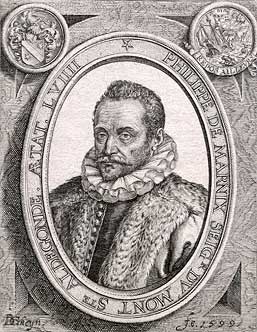Aldegonde, Philips van Marnix, Heer van Sint (1540-1598)

Philips van Marnix St. Aldegonde was born 1540 at Brussels, and died 1598 at Leiden. He was educated at the universities of Leiden, Paris and Dole. At Dole he broke with Catholicism in 1558 to become a follower of Calvin. He traveled through Italy, and in 1559 came to Geneva, where he presumably stayed until 1562. About this time he came in contact with William of Orange and became an indefatigable fighter in the revolt against the Spanish King Philip II, who also ruled over the Netherlands. He defended the notorious iconoclasm of 1566 in two pamphlets of 1566 and 1567. For these martial followers of Calvin and Beza the uprising was first of all a religious conflict between the Christian truth and Rome.
Marnix van St. Aldegonde filled important and responsible positions. He remained a good friend of William of Orange, although later a serious difference of opinion arose between them. Whereas William was inclined toward tolerance toward other creeds, Aldegonde had no tolerance whatever. Though he might have been inclined to tolerate the Roman Catholics politically, he did not take the same attitude toward the Mennonites, calling them fanatics and intolerable in the state (Ondersoeckinge . . . der Geestdrijuische Leere . . . , 1595; Responce Apologétique, 1598). He considered death a fitting penalty for Anabaptists. He tried to persuade William to take severe measures against them, but was not successful. In a letter of 31 March 1577 to the Reformed preacher Caspar Heidanus at Middelburg, Aldegonde wrote about "the matter of the Anabaptists," whom he calls people "who seek to destroy the bond of all human society." The prince, he continues, will have nothing to do with suppressive measures and will not oppress the Mennonites, both as a matter of principle and of practical statesmanship.
After 1585 Aldegonde retired from politics, devoting himself principally to letters. Among other writings he wrote the Psalms in rhyme and began a translation of the Bible as a commission from the Dutch States-General, but completed only a small part of it.
Bibliography
Schelven, A. A. van. Marnix van St. Aldegonde. Utrecht, 1939.
Dankbaar, W. F. Hoogtepunten uit het Ned. Calvinisme in de 16e Eeuw. Haarlem, 1946, Chapter II: 41-85: "Marnix van St. Aldegonde en zijn betekenis voor de vestiging van de Nederl. Geref. Kerk."
Brandt, Geraert. Historie der reformatie, en andre kerkelyke geschiedenissen, in en ontrent de Nederlanden : Met eenige Aentekeningen en Aenmerkingen. Amsterdam : J. Rieuwertsz : H. en D. Boom, 1671-1704, v. I.
Molhuysen, P. C. and P. J. Blok. Nieuw Nederlandsch Biografisch Woordenboek, 10 vols. Leiden, 1911-1937: Available online at http://www.dbnl.org/titels/titel.php?id=molh003nieu00: I, 1307.
Hege, Christian and Christian Neff. Mennonitisches Lexikon, 4 vols. Frankfurt & Weierhof: Hege; Karlsruhe: Schneider, 1913-1967: v. I, 43.
| Author(s) | Nanne van der Zijpp |
|---|---|
| Date Published | 1955 |
Cite This Article
MLA style
Zijpp, Nanne van der. "Aldegonde, Philips van Marnix, Heer van Sint (1540-1598)." Global Anabaptist Mennonite Encyclopedia Online. 1955. Web. 16 Apr 2024. https://gameo.org/index.php?title=Aldegonde,_Philips_van_Marnix,_Heer_van_Sint_(1540-1598)&oldid=146354.
APA style
Zijpp, Nanne van der. (1955). Aldegonde, Philips van Marnix, Heer van Sint (1540-1598). Global Anabaptist Mennonite Encyclopedia Online. Retrieved 16 April 2024, from https://gameo.org/index.php?title=Aldegonde,_Philips_van_Marnix,_Heer_van_Sint_(1540-1598)&oldid=146354.
Adapted by permission of Herald Press, Harrisonburg, Virginia, from Mennonite Encyclopedia, Vol. 1, p. 42. All rights reserved.
©1996-2024 by the Global Anabaptist Mennonite Encyclopedia Online. All rights reserved.
